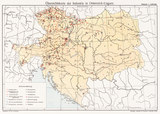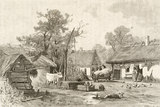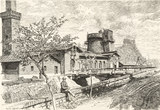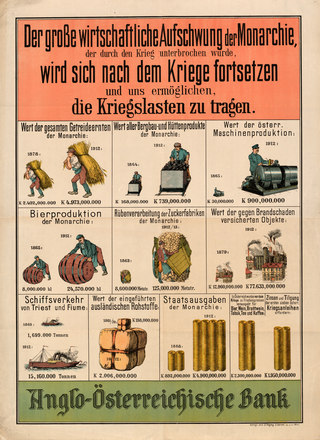Different speeds: economic development
-

Overview map of industry in Austria Hungary, 19
Copyright: Schloß Schönbrunn Kultur-und Betriebsges.m.b.H./Fotograf: Alexander E. Koller / Objekt aus Privatbesitz
-

Johann Greguss: Farm on the Hungarian plain, illustration, 1891
Copyright: Schloß Schönbrunn Kultur-und Betriebsges.m.b.H./Fotograf: Alexander E. Koller
-

Hugo Charlemont: Fürstlich Salm’sches iron casting works in Blansko (Moravia), illustration, 1897
Copyright: Schloß Schönbrunn Kultur-und Betriebsges.m.b.H./Fotograf: Alexander E. Koller
The Habsburg Monarchy incorporated territories with very different cultural, social and economic development. This variety, which was extremely fecund at the cultural level, proved to be an obstacle to the modernization of the state as a whole.
There were extreme differences in the state of development within the Dual Monarchy, even if the infrastructural development – above all the railways – had brought about a certain homogenization, which by 1900 had even reached the edges of the empire.
The regional disparity was nevertheless considerable. Within the Habsburg Monarchy there were highly developed industrial conurbations as well as backward agrarian regions. There were also significant differences between the two halves of the empire. In Cisleithania, the Bohemian territories, particularly north and central Bohemia, and the heavily industrialized centre in the area of Mährisch Ostrau [Moravská Ostrava] had the highest proportion of industry. Mechanical engineering and the food industry were particularly important, while the textile industry, which around 1880 had accounted for a third of industrial production, was increasingly declining in significance.
In the Austrian Alps and Danube region, Vienna and the surrounding industrial area and the traditional metalworking and mining centres in the Alpine lands were the most highly developed regions. By contrast, the Carpathian (Galicia and Bukovina) and Adriatic regions (Dalmatia and the peripheral areas of Carniola and the coastland) were barely touched by industrialization and thus exerted a negative influence on the overall figures. Despite this, industry was still the most important production factor in the Austrian half of the empire in 1900.
In Hungary, by contrast, agriculture remained the most important economic sector. One problem, however, was the imbalance in land ownership. Production was dominated by large landowners, whereas the farming methods in the mass of smallholdings were backward. The rural population lived in miserable circumstances. In Hungary in 1900 there were 4 million propertyless farm workers in Hungary, around one fifth of the population, who for the most part subsisted at below the poverty level. Within the farming community only around one third of the estates had sufficient land to produce anything for the market surplus to their own requirements.
Even in Hungary, however, a shift was beginning to take place from agriculture to industry. In Budapest and central Hungary in particularly growth rates were extremely high. The belated industrialization was also a consequence of a shortage of capital. Half to a third of the invested capital came from Cisleithania and abroad, mainly Germany.
One interesting phenomenon in the Habsburg Empire was the division of labour between the different large regions. In the Austrian Alpine and Danube regions, the tertiary sector (administration, education, commerce and services) predominated, whereas in the Bohemian territories industry was foremost. Meanwhile, Hungary and the Carpathians were the agrarian grain store. This produced a situation of economic interdependence, making the Habsburg Monarchy into a self-contained economic region with little integration with the rest of Europe.
Translation: Nick Somers
Brusatti, Alois/Wandruszka, Adam (Hrsg.): Die Habsburgermonarchie 1848–1918, Band I: Die wirtschaftliche Entwicklung, Wien 1973
Rumpler, Helmut: Die Gesellschaft der Habsburgermonarchie aus der Perspektive der Bevölkerungs-, Siedlungs-, Erwerbs-, Bildungs- und Verkehrsstatistik 1910, in: Rumpler, Helmut/Seger, Martin (Hrsg): Die Habsburgermonarchie 1848–1918, Band IX/2: Soziale Strukturen, Wien 2010, 9–26
Sandgruber, Roman: Ökonomie und Politik. Österreichische Wirtschaftsgeschichte vom Mittelalter bis zur Gegenwart [Österreichische Geschichte, hrsg. von Herwig Wolfram], Wien 1995
Seger, Martin: Räumliche Disparitäten sozioökonomischer Strukturen in der Spätphase der Habsburgermonarchie. Die Gleichzeitigkeit des Ungleichzeitigen, in: Rumpler, Helmut/Seger, Martin (Hrsg): Die Habsburgermonarchie 1848–1918, Band IX/2: Soziale Strukturen, Wien 2010, 27–44


